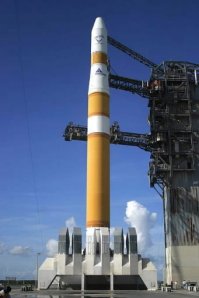Update: Delta IV Set to Launch
Update: Following a scrub on Thursday due a problem with helium pressurization, the launch of the Delta IV carrying SatCom 5 has been reset for 8:37 p.m. EDT this evening.
Original:
After a stand down dating back to October 4th , a United Launch Alliance (Boeing) Delta IV is prepared to return to flight this evening in a 30 minute launch window which begins after sunset over Cape Canaveral. Although the review into the 2nd stage fuel leak in the RL-10B engine has not been formally closed, tonight’s vehicle, carrying the $342 million Wideband Global SATCOM 5 satellite has been thoroughly inspected and cleared for launch.
Once thought destined to be America’s premier commercial launch vehicle, the all cryogenic Boeing Delta IV was pulled from the commercial market after its maiden flight in 2002, after it proved to be uncompetitive. The Delta IV remains in service as a stable mate to more popular Atlas V, which offers somewhat lower overall costs due in part to its kerosene/ oxygen first stage architecture, powered by the imported Russian built RD-180 main engine. With both vehicles heavily subsidized as part of the Evolved Expendable Launch Vehicle program, it is difficult to get real reading on what either actually costs the taxpayer, particularly since ULA, unlike SpaceX, which is currently seeking to enter the EELV market, refuses to disclose prices. (No one discloses costs)
While the Delta IV will continue to serve the Defense Department for years to come, especially in its heavy configuration and presumably alongside the Falcon Heavy, for those interested in the progression of the space launch systems as they apply to lowering the costs of reaching orbit, and operating in deep space, the saga of the Delta IV represents a nearly two decade long diversion in what might have been. While NASA has one scheduled flight of the Delta IV Heavy, purchased by Lockheed Martin to test the Orion spacecraft, the relatively high costs of the booster, $375 million for that mission, (exclusive of the Launch Capability Contract/subsidy) have been an impediment to the serious consideration of alternative exploration architectures such as fuel depots, or other critical elements to exploration such as Mars sample return or atmospheric entry demonstrations. When the only tool at your disposal is too expensive to use, drawing up plans to use it is generally an exercise in futility.
Some have suggested that the same might apply to Space Launch System.


